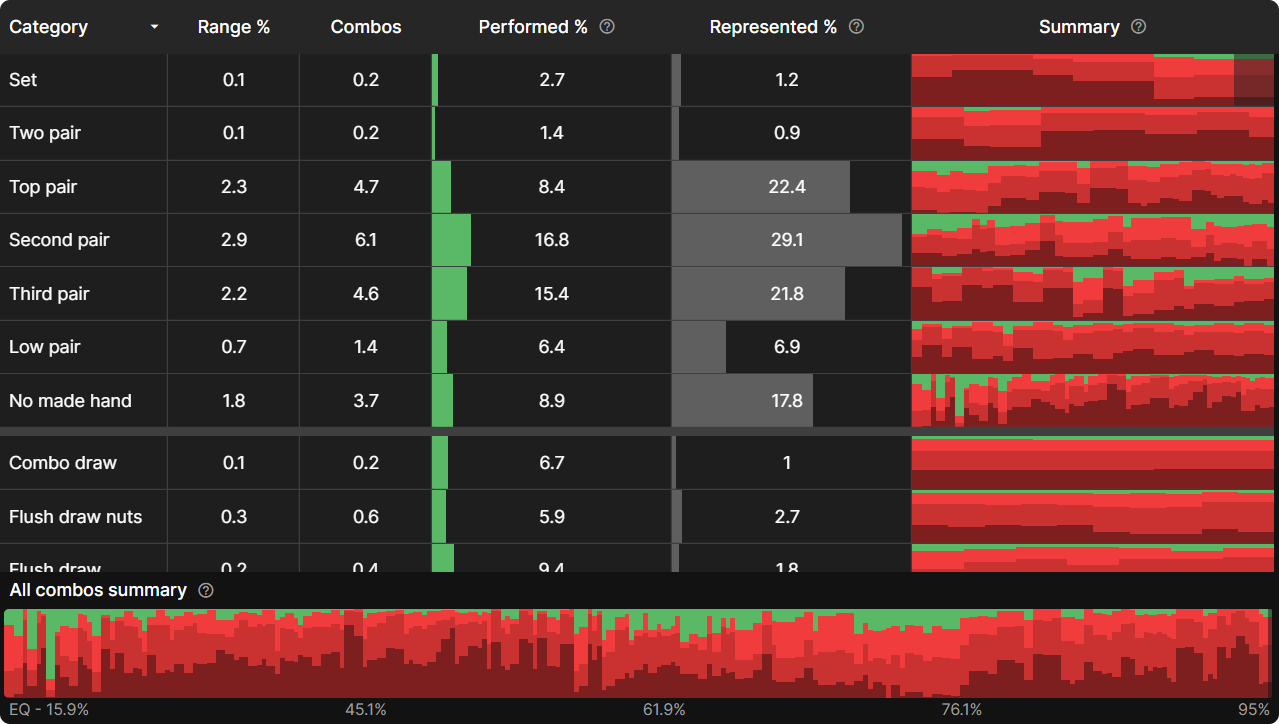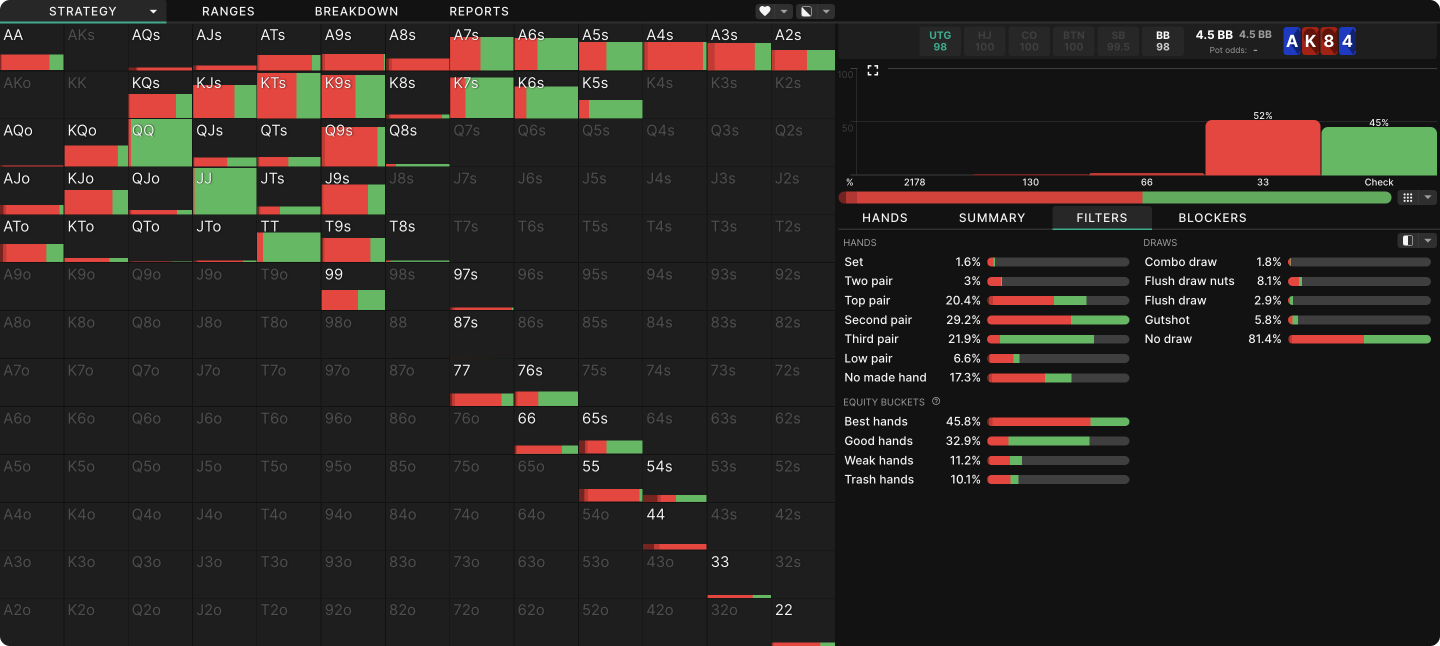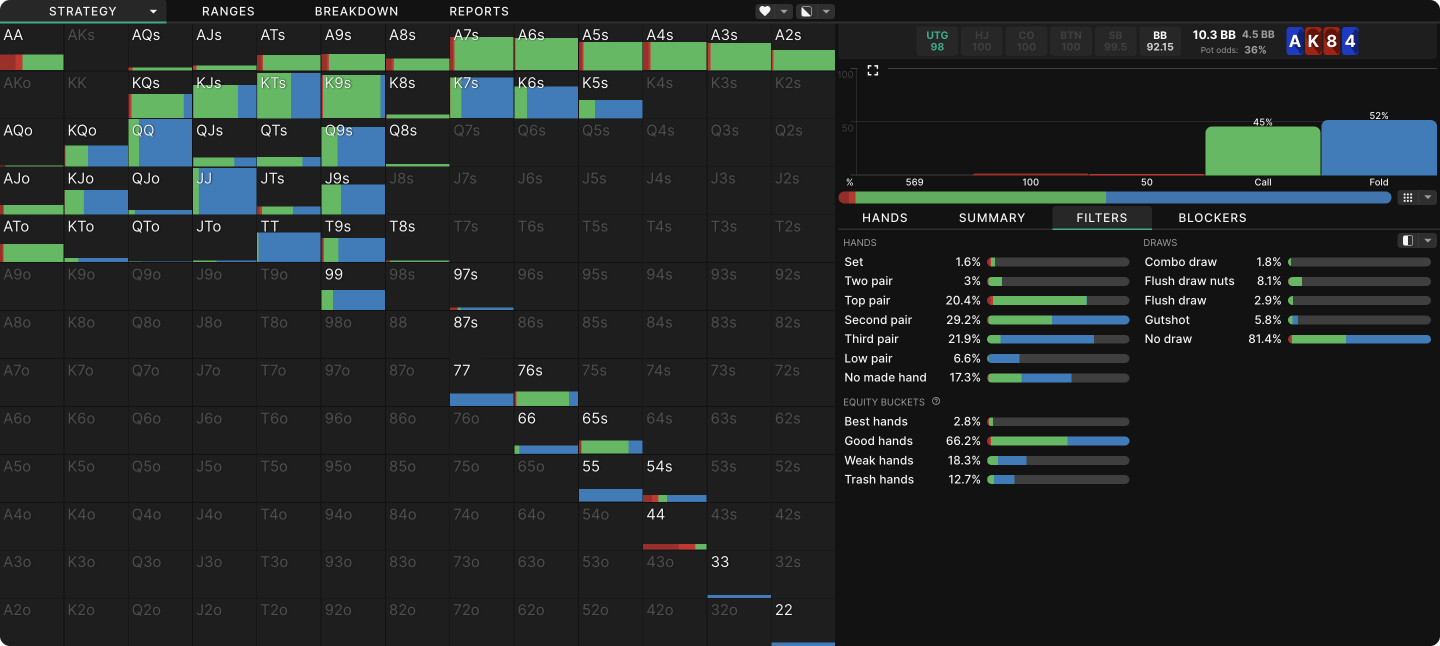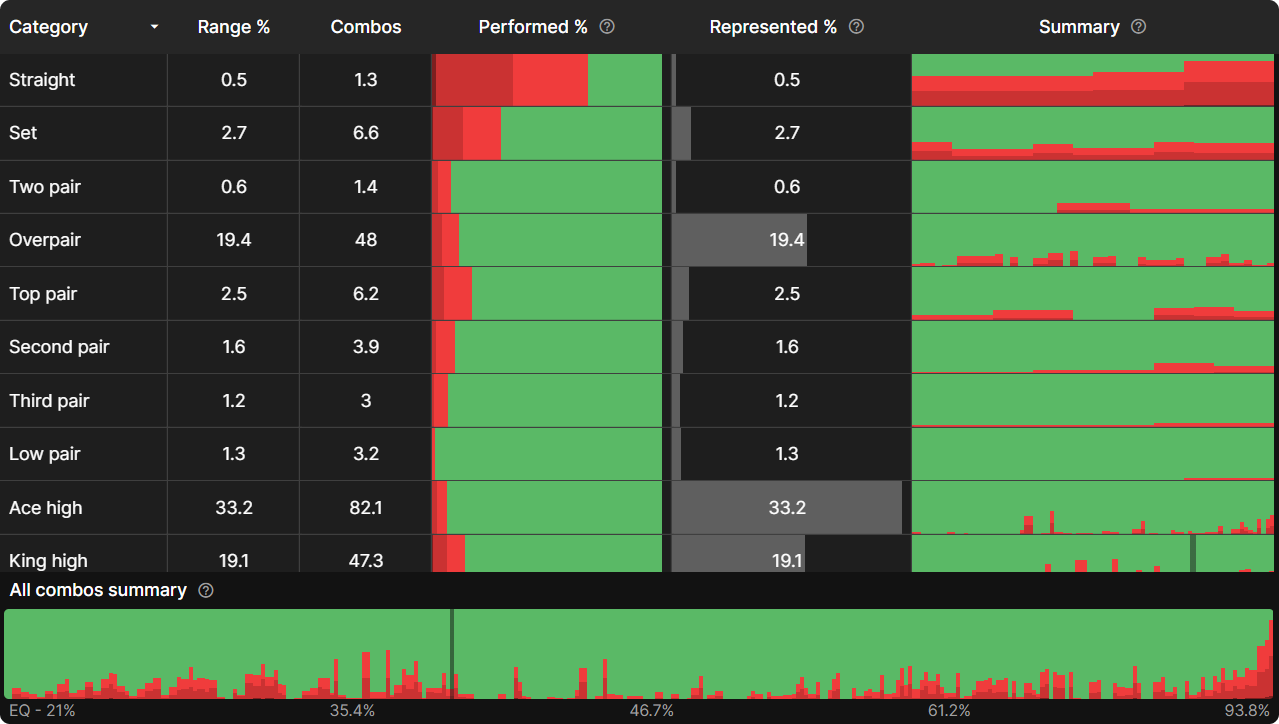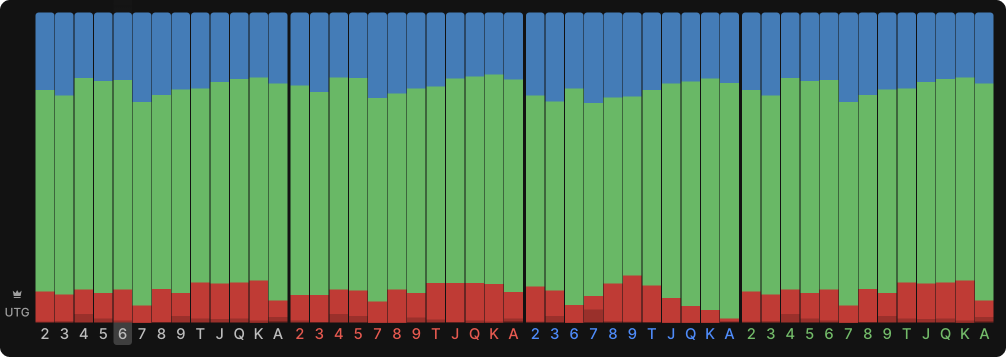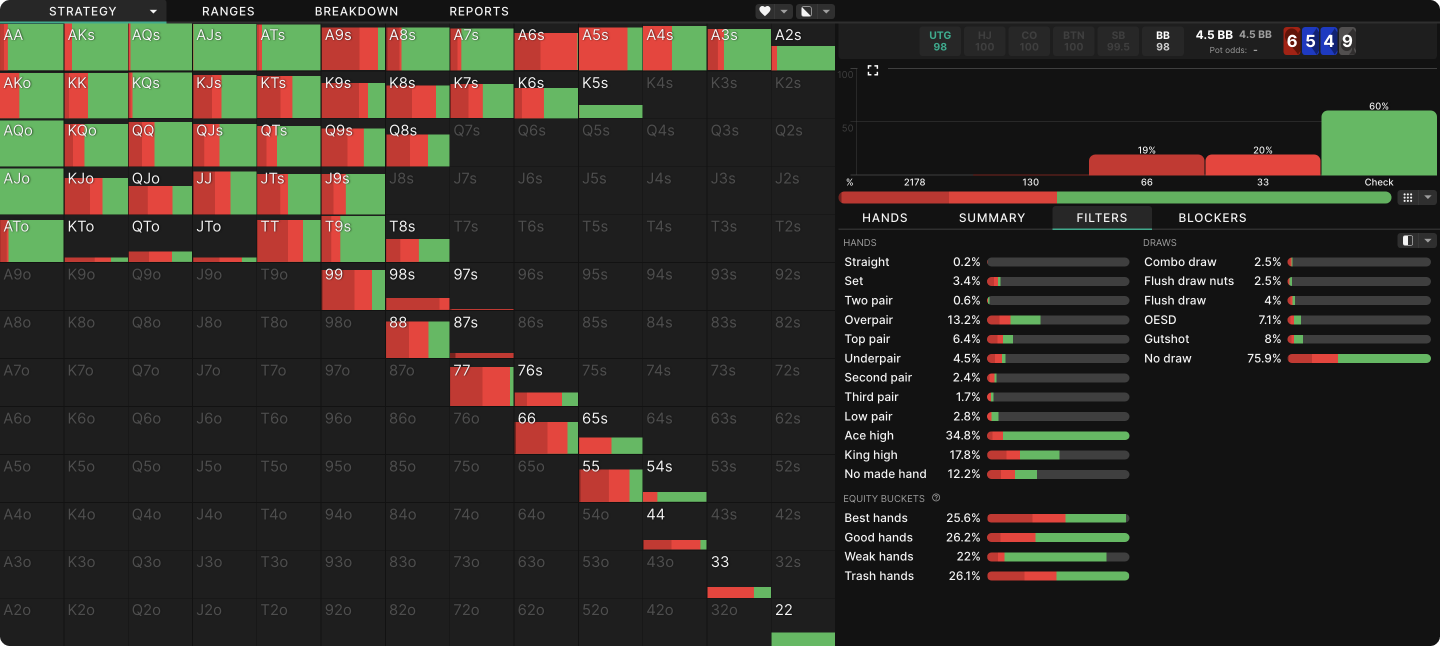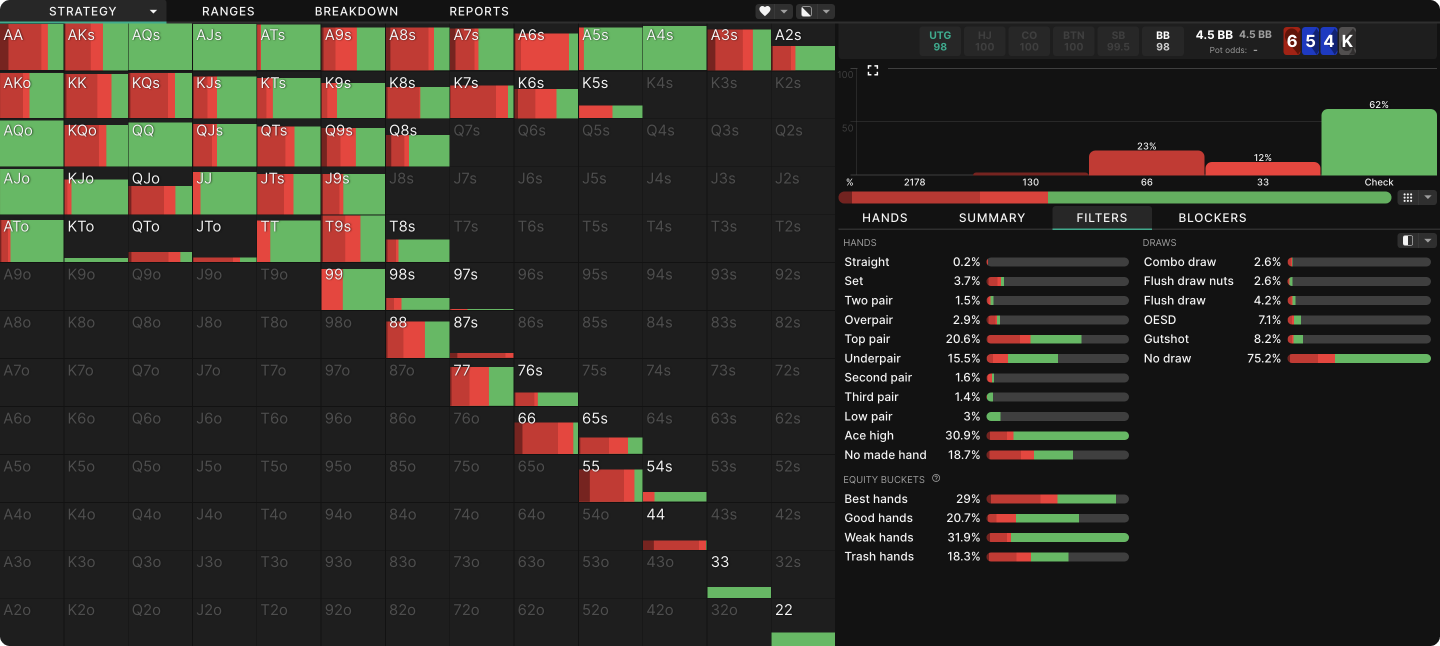Delayed C-Betting

This is a companion piece to Probe Betting. It stands on its own, but understanding how to play these scenarios from both sides will enhance your overall understanding of the underlying concepts. A “delayed c-bet” means checking the flop as the preflop aggressor, then betting the turn.
Many players believe that if they check the flop after raising pre-flop, they have “shown weakness” and must therefore respond stubbornly to any aggression on future streets. This belief is not baseless: by declining to bet, you have not allowed your opponent to fold their weak hands, so they will have plenty of bluffing candidates on later streets. An opponent who chose to bet all of them would in fact be bluffing too often, and stubbornly calling down would be the correct exploitative adjustment.
By declining to bet, you have not allowed your opponent to fold their weak hands, so they will have plenty of bluffing candidates on later streets.
They are not required to overbluff, however, and it is not correct for them to do so. On most turns, you should expect them to check fairly often, at which point you will be able to value bet more thinly than on the flop. If they do bet, you should rarely raise, as your flop check makes it unlikely you will hold a nutty hand. The opportunity to act with the benefit of this additional information is a big part of what incentivizes checking in the first place.
We will examine two examples in greater detail: one where the pre-flop raiser enjoys a large equity advantage on the flop and one where the equity is evenly distributed. Both examples assume a single raised pot, LJ vs BB, in a 100bb cash game, but the general principles discussed here will apply in any situation where a player who had been the aggressor stops betting.
A Favorable Flop
LJ’s checking range consists of three types of hands:
- Robust, medium-strength hands like A2, K6, and JJ, which gain little from folds and do not perform well in large pots.
- Extremely weak hands with little hope of improving. LJ sometimes checks 7♠ 6♠ but never 7♥ 6♥ and rarely 7♦ 6♦. This check is not “giving up” – LJ will bluff eventually. These hopeless airballs make just as much bluffing later, to represent a delayed value bet, as they would betting immediately.
- Monster hands with heavy blocking effects. On this board, that just means AA. Mostly, LJ wants to start betting their strong hands immediately to give themselves a chance to get three bets paid off. Because so much of BB’s range for calling three streets is Ax, however, AA doesn’t give up anything by checking because it’s not likely to get three streets anyway.
You can see this effect in the image below, which shows LJ’s checking range concentrated around medium pairs and “No Made Hand”.
On this board, LJ retains a range advantage on all turns, even after checking. Consequently, the BB ought to check to them quite often, at which point they can bet many of the hands they declined to bet on the flop.
Thin Value Bets
All this checking serves to promote hands.
Essentially, all this checking serves to “promote” hands, making them more valuable than they were on the previous street, even when they have not improved in rank. When LJ checks the flop, BB can reasonably conclude they are unlikely to hold AK, AQ, KK, 88, and other very strong hands. This incentivizes them to call bets lighter on later streets, which in turn incentivizes LJ to value bet more thinly than they did on the flop. LJ can also bet more thinly after seeing BB check a second time, as this similarly makes strong hands less likely for BB. On the flop, LJ mixed between betting and checking A9 and AJ. If BB checks again on a 4♦ turn, LJ purely bets these hands.
However, BB’s second check is not a license for LJ to bet with abandon. In fact, they now have even more incentive to check their most medium hands: QQ, JJ, and TT. This is a common turn dynamic, where players are incentivized to play more honestly than on the flop.
Responding to Bets
Turn bets from the BB should be rare but large. LJ, having mostly capped their range by checking the flop, rarely raises. The bigger the bet, the more rarely LJ raises. Mostly they are playing a bluff-catching game where the objective is to avoid folding at greater than Minimum Defense Frequency.
Facing a 130% pot bet, for instance, they can call profitably with any Ace because it blocks many of BB’s value hands. With lower pairs, they are indifferent or pure folding. Their few raises are almost exclusively slowplayed monsters (AA) or turned monsters (44, A4).
This range includes some counterintuitive calls, specifically the gutshots like 7♠ 6♠ which have just four outs, two of which are not even to the nuts. These calls rely on river bluffs for much of their EV. The obvious hands with which LJ would check the flop and then call an overbet on the turn all have too much showdown value to bluff when checked to on the river. Thus, BB should mostly not pay off bets after checking the river, and bluffing with the rare weak hand ought to be profitable enough for LJ to make calling turn with a gutshot no worse than folding.
That’s the theory, anyway. It relies on your opponent doing some sophisticated hand reading and disciplined folding to work, and even when it works, it still makes peeling the turn with 7♠ 6♠ no better than folding. As a mixed strategy, this particular decision offers a low-risk opportunity for exploitative adjustment, and you would do well to fold against opponents you do not consider particularly sophisticated or disciplined.
The fact that this board is especially good for the pre-flop raiser is not a reason to fight back extra hard against the BB’s turn bet. In fact, it is reason to be wary: this situation ought to be scary for the BB, yet they are shoveling money in anyway.
An Unfavorable Flop
Medium connected flops help the BB catch up to the pre-flop raiser’s range advantage better than most. The LJ’s strategy here must begin with the acceptance that this was an unlucky flop and they are not going to win the disproportionate share of equity they would on many other flops. Trying to force it by continuation betting at a high frequency anyway exposes them to check-raises from the BB which will deny their equity. For the most part, the best the LJ can do is check behind and hope the turn card is better for them than the flop was.
The LJ must accept that this was an unlucky flop and they are not going to win a disproportionate share of equity.
Because the turn can so easily improve LJ’s range, they have less incentive to slowplay monsters. What little continuation betting they do comes primarily from sets and straights.
Responding to Bets
LJ has a relatively capped range after checking, so they rarely raise turn bets.
LJ has a relatively capped range after checking, so they rarely raise turn bets. Even facing a small 33% pot bet, raise is LJ’s least used option on all turns.
On the worst turn cards, which put four-card straights on the board, LJ folds often enough to give BB profitable bluffs with any two cards, but mostly LJ continues at the Minimum Defense Frequency.
LJ’s response to a bet is not significantly more aggressive on the turn cards that are best for them, such as A or K. As on the AK8 board, the fact that the turn favors the LJ ought to be built into BB’s betting range. BB checks more often on these cards, but when they do bet, their range is strong and LJ has little incentive to raise.
When LJ does raise, they do so mostly with slowplayed monsters and hands improved by the turn card. For example, on a 9s turn, they raise not only sets and straights but also A9, K9, 98, and 97.
LJ raises mostly slowplayed monsters and hands improved by the turn.
Thin Value Bets
Whether LJ value bets more thinly after BB checks a second time depends on how much the turn card helps them. On the 9s, which does not improve many of the unpaired hands with which they checked the flop, LJ consistently bets strong but vulnerable pairs such as A6, A5, and smaller overpairs. They continue to check AA and KK heavily, however, as a check-raise from a polarized range remains a threat.
LJ’s weaker pairs benefit from multiple promotion effects after this action. The combination of the flop check and the blank turn leaves A5 fairly high up in LJ’s range, even though it’s just third pair.
Compare this to a Ks turn, which improves many of the weaker hands in LJ’s flop checking range. Now A5 is no longer so high in LJ’s range and so never bets. The medium pocket pairs bet less often as well.
Conclusion
Taking the pot immediately is always nice, but an in-position player can sometimes do better than stabbing into the dark by gathering more information before investing. By checking behind, they get to see the next card and their opponent’s next action, both of which help them value their hand more accurately.
Medium-strength hands benefit most from this additional information, so checking weights the aggressor’s range toward such holdings. As a result, they are not terribly aggressive after checking. If the opponent bets, they mostly play a bluff-catching game, aiming to call down at a frequency that makes the opponent indifferent to bluffing and rarely raising.
This is not the primary branch of the game tree where the check pays off. Some of your hands will face some tough decisions if your opponent bets into you, and it’s ok to have no good options when that happens. You got unlucky that they bet and unlucky to hold the kind of hand that would face a difficult decision. Sometimes you just have to make the best of a bad situation. It is better to think of these scenarios as the price of doing business, a cost you occasionally pay in exchange for the benefit of getting a lot of profitable opportunities when your opponent checks a second time.
If the opponent checks again, as they should do relatively often on all but the most favorable boards, the in-position player now has a lot more leeway to make thin value bets, to bluff into a twice-weakened range, and to keep the pot small depending on what their hand prefers. This opportunity to make better decisions when armed with more information is a big part of what the aggressor buys themselves by checking on the previous street.
Author
Andrew Brokos
Andrew Brokos has been a professional poker player, coach, and author for over 15 years. He co-hosts the Thinking Poker Podcast and is the author of the Play Optimal Poker books, among others.
